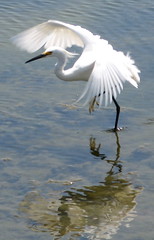A story in this morning’s Chron describes a billion-dollar plan to open up old Cargill salt ponds, build strong levees and let nature take its course, which should mean hundreds and perhaps thousands more birds and other wildlife in the Don Edwards National Wildlife Sanctuary and other areas along the San Francisco Bay.
Great for birdwatchers, you say, but what’s in it for hikers? Won’t the trails all be flat as a board? Won’t there be a skunky smell from all that shallow standing water?
Yes and yes.
But I still enjoy taking a walk along the old levees and watching the waterfowl come in for landings. The Canada geese are particularly entertaining when they’re in town. They’re noisy, territorial, amazing to watch in flight and humorous to watch when they try to land on water: a million years of evolution and they’re still terrible at it.
Egrets are fun to watch as they inch along through the shallow water, casually taking flight if you get too close. It’s like they know they can fly away, so they don’t get to worked up when pedestrians pass.
I live closest to the Alviso entrance to the refuge. There’s almost always some foul odor on the breeze, trains rumble through every 20 minutes or so, but there’s something refreshing about being in the midst of all these birds, bugs and swimming creatures right next door to industry and civilization.
Here’s a look at what’s in store in the bay restoration plan, from the Chron story:
Some of the restoration projects planned for the former salt ponds:
— A 2 1/2-mile segment of the Bay Trail will open between Mountain View’s Stevens Creek and Sunnyvale for hiking, biking and watching wildlife. Ducks flock there in the winter, and herons and egrets feed year-round. The least terns that breed on the former Alameda Air Station, which environmentalists want to secure for the refuge, bring young there in August to feed and learn how to fish before the winter migration to Mexico.
— Near Santa Clara and Alviso, managers will open about 900 acres of ponds to the tides, bringing the new tidal marsh there to about 1,400 acres. Brown and white pelicans, ruddy ducks and double-crested cormorants feed there. People walking near about 250 acres of shallow ponds with 50 nesting islands will see American avocets, black-necked stilts and Forster’s terns. Thousands of western and least sandpipers, grebes, marbled godwits and dunlins come in the winter.
— Near Hayward, the agencies will build an interpretive site with raised walkways and viewing platforms overlooking the remnants of old salt works. Birds and ducks will congregate at some 230 acres of ponds and 630 acres of tidal habitat.
The story notes that as soon as the old Cargill salt ponds were flooded in recent years, within days fish started swimming in, and birds started following the fish. Funny how that works.
Here’s a link to the Don Edwards home page. For driving directions to visitors centers, go here. (Note the page says do not use “Internet driving directions” — apparently the refuge visitor centers aren’t listed in the systems Google maps and everybody else uses.)


I’ve often enjoyed strolling the levees, and I’m truly glad to see new trail connecting north from Sunnyvale. Now there’s a plan that’s worth it’s salt!
I’m particularly fond of these Bayside open spaces, Hayward Shoreline, San Leandro Bay, Don Edwards. They are significant because not only can you document and photograph (ME? PICTURES?) innumerable species of birds, those places are what got me to rehabbing once I had to use a chair. If you’re lucky and have a good tide, you can see the sharks in the shallow water. Good times had out there by the Bay. Smell or not, flat or not.